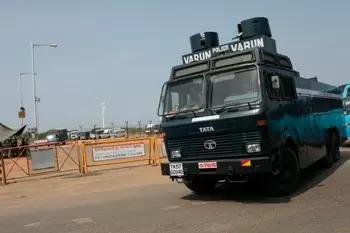There is more to worry about the Kudankulam plant than a nuclear accident

11-May-2012
Vol 3 | Issue 19
About 500 people, an overwhelming majority of them women, have been on an indefinite peaceful fast since 1 May at Idinthakarai, a fishermen hamlet next to the Koodankulam Nuclear Power Project (KKNPP).
Curfew orders have been promulgated and more than 2,000 police men have surrounded the area, creating an impression the hapless protesters are under siege.
 |
|
The Tamil Nadu police is threatening to use force to quell a peaceful and democratic struggle
|
Thousands after thousands of people from neighbouring villages have surrendered their voter ID cards, claiming, “we are surrendering our freedom and democratic rights at the altar of a few hundred megawatt of destructive nuclear power.”
Inside the KKNPP complex, there was a loud explosion on 4 May. The authorities are tightlipped on the blast.
Though the complex has medical facilities, two injured workers, Sivakumar and Esakkimuthu, were admitted to a private hospital at Anjugramam in Kanyakumari district.
“NaturanNews,” meanwhile, has put out an “insider alert” that the spent fuel pool of Fukushima reactor No. 4 is just one earthquake away from a structural failure that could set off a chain of events leading to the release of up to 85 times the Cesium-137 released in the Chernobyl disaster.
Mitsuhei Murata, former Japanese Ambassador to Switzerland and executive director of the Japan Society for Global System and Ethics, has said: “It is no exaggeration to say that the fate of Japan and the whole world depends on No 4 reactor.”
A failure of the reactor’s spent fuel pool and the subsequent catastrophic release of Cesium would decimate human life even across North America, destroying crops, polluting ground water, causing widespread stillbirths and unleashing an explosion in cancer rates. The land could become uninhabitable for centuries.
It may be pointed out that work on the KKNPP was resumed on the expert advice of scientists and engineers of the Department of Atomic Energy, Bhabha Atomic Research Centre and the Nuclear Power Corporation of India Limited, none of whom is familiar with or experienced in Pressurised Water Reactor (PWR) technology which is used in the Russian VVER type reactors at Koodankulam.
These experts, entrusted with the task of designing a PWR nuclear submarine propulsion plant, gave up after 10 years of sustained effort and spending considerable sum of money. It was then that India sought Russian help for the nuclear submarine project.
The Russians utilised the opportunity to sell VVER type nuclear reactors which were dumped on the unwilling people of Koodankulam in Tamil Nadu after Kerala refused to locate it.
Nuclear power plants are water guzzlers. Tamil Nadu is not endowed with abundant supply of fresh water. According to Atomic Energy Regulatory Board instructions of 1998, the Koodankulam project requires two sources of water from the reservoirs of Pechiparai and Upper Kodyar in Kanyakumari district to ensure adequate supply in the event of a loss-of-coolant accident, the biggest potential hazard of reactors.
No step has been taken so far to convey water from these reservoirs to Koodankulam in Tirunelveli district. Kanyakumari is the only lush green district in Tamil Nadu.
Diverting water from its two reservoirs would not only turn it into a desert but also destroy the southern rice bowl of the State. NPCIL’s post-Fukushima safety task force report says that while the Madras Atomic Power Station at Kalpakkam has water reserve of 77.3 cubic meters per MWe, Koodankulam has only 5.1 cubic meters.
Since water from Pechiparai and Kodyar is ruled out, four mega desalination units, each producing 106,000 litres of water an hour, is provided for the first unit of the Koodankulam plant.
These units will suck in enormous quantities of sea water along with microscopic to tiny sea flora and fauna, phytoplankton, zooplankton, fish eggs and larvae of myriad sea creatures.
The harm to marine life and pelagic birds will be enormous when the concentrated brine waste and the waste of chemicals used to demineralise the desalinated water are dumped into the sea.
The Arabian Gulf is dotted with desalination plants as its hinterland is mostly desert. The people who live there rely on desalinated water for all their needs from drinking to irrigation at a high environmental cost.
Excessive discharge of wastes has given rise to a biological phenomenon called “red tide” in such locations caused by high concentration of poisonous microscopic algae.
Though scientists call it harmful algal blooms, the red tides cannot be controlled by human beings. The organisms produce a toxin that paralyses the central nervous system of fish.
Molluscs, clams and oysters too are not immune to red tide. These tides are harmful for humans even to be around because their presence in mist from breaking waves can cause burning eyes and respiratory problems. Toxic seafood causes numbness of mouth, tingling of fingers, paralysis and even death.
The narrow Gulf of Mannar that separates Koodankulam from the northwest coast of Sri Lanka is the world’s richest marine biological resource and it must be protected.
There are 21 uninhabited islands with estuaries, beaches, forest of the near-shore environment with marine algal communities, sea grasses, coral reefs, salt marshes and mangroves.
 |
|
Police show of strength in Kudankulam against a peaceful struggle
|
People living on both sides of the Gulf of Mannar are dependent on the area’s marine resources for subsistence, livelihood and for employment. The ocean is the cradle of life with a delicate web of food chain that supports its biodiversity.
Even if a nuclear catastrophe never takes place at the Koodankulam power plant, there looms a serious threat from a chain reaction in the Gulf of Mannar from the yet to be commissioned desalination behemoths and the fishing community in the coastal villages surrounding Koodankulam is a worried lot.
The government, on its part, has added to the people’s worry by keeping under wraps information relating to safety, site evaluation and environmental impact of the nuclear power plant.
There are genuine public apprehensions about the safety of nuclear power. The non-transparent functioning of the Department of Atomic Energy, directly under Prime Minister Manmohan Singh himself, has only added to the apprehensions of the people.
The DAE never takes the public into confidence in incidents of radioactive leakages in nuclear power plants like the ones at Kalpakkam and Kakarpar.
Citizens come to know about these from external sources like the IAEA. Any nuclear installation or site must be designed in a way to account for any unforeseen accidents and natural hazards. This is the basic purpose of a safety evaluation and citizens have a right to know the safety assessment of the KKNP project.
Disclosure of the site evaluation and safety assessment reports will enable citizens to get a holistic understanding of the project, including environment and safety concerns. All over the world, site evaluation and safety analysis reports of nuclear power plants and installations are put in public domain to elicit the people’s views. India cannot be an exception.
The Atomic Energy Regulatory Board is yet to approve the emergency response plan of the Koodankulam plant which is mandatory for beginning of operation of a nuclear power plant.
The plant management should ensure that the emergency preparedness and response plan are approved by the AERB and necessary training given to the personnel implementing the plan.
According to the AERB guidelines, the district collector would be designated as the off-site emergency director. Without having an approved emergency preparedness plan in place, Russian engineers at the plant site are preparing to load enriched uranium fuel to the Koodankulam reactor core which is a violation of the provisions of the Atomic Energy Act, 1962, and the Atomic Energy (Radiation Protection) Rules, 2004.
The NPCIL, implementing the Koodankulam project, is liable to be prosecuted under Articles 14 and 21 of the Constitution for not obtaining the mandatory emergency preparedness plan approved.
Construction of the Koodankulam power plant within 500 meters of the High Tide Line is a gross violation of the Coastal Regulation Zone rules adopted in 1991 and subsequently revised in 2011.
The project will definitely affect the lives and livelihood of the people living in the area. About 150,000 people live in villages within an eight-kilometer radius of the plant. The radioactive particles leaked out will be harmful to the health of the people and the environment of the marine system.
Commissioning of the plant just because Rs. 14,000 crore had been spent on it so far will pave the way for spending Rs. 500,000 crore for other coastal nuclear power parks in the country like Kovvada in Andhra Pradesh and Jaitapur in Maharashtra.
Nuclear power, after all, is the energy of the past and not of the future. Japan has switched off the last of its 54 reactors on 5 May as thousands marched to celebrate the nation’s freedom from nuclear power for the first time in nearly five decades waving banners shaped as giant fish, a potent anti-nuclear symbol.
Germany plans to completely reverse its nuclear programme from a current share of 26 per cent of its energy requirements to zero per cent in the next 10 years and shift to solar and other renewable sources.
While the advanced countries are looking at future sources of energy, India is looking backwards and acquiring discarded nuclear reactors.
Sam Rajappa is Consulting Editor of The Weekend Leader














